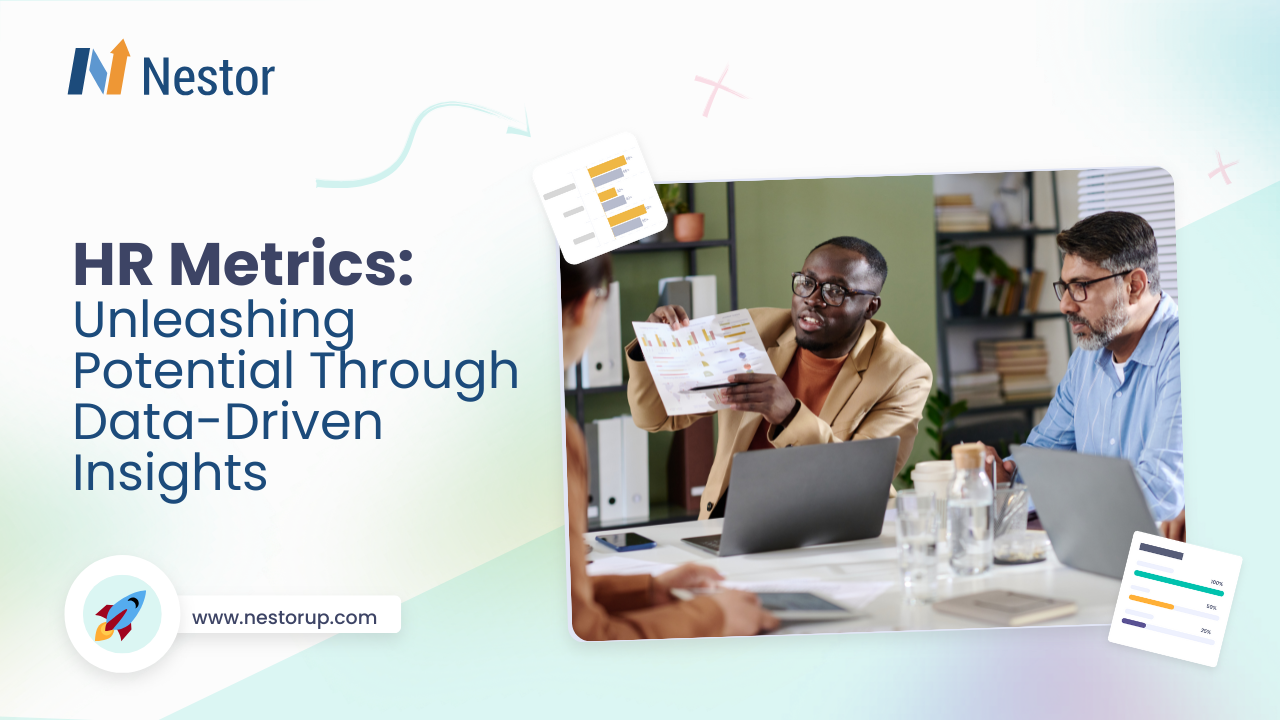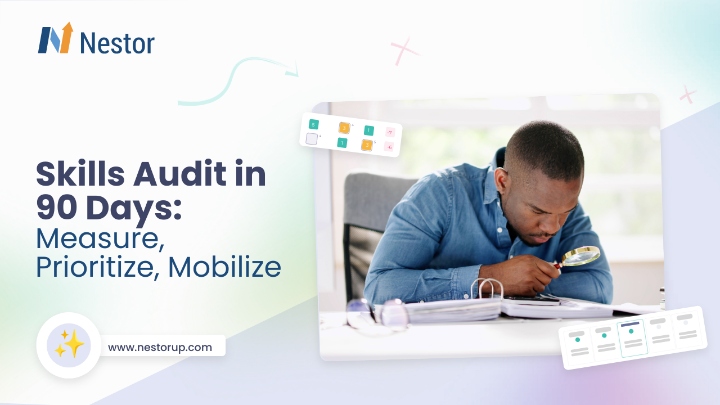HR Metrics: Unleashing Potential Through Data-Driven Insights
17 min read

Contents
HR metrics have come a long way from basic headcount and turnover rates. They’ve transformed into sophisticated tools that provide invaluable insights into an organization’s most precious asset: its people. These powerful indicators are revolutionizing how organizations approach skills management, employee development, performance evaluation, and strategic planning. From identifying critical skills gaps to measuring the return on investment of learning initiatives, HR metrics offer a window into the complex dynamics that drive workforce productivity and potential.
The ability to measure, analyze, and act upon meaningful data has become a cornerstone of organizational success. Every decision about your workforce can be backed by solid data, allowing you to predict future skill needs with remarkable accuracy and quantify the impact of your training programs down to the dollar. This isn’t a far-off fantasy; it’s the reality that HR metrics can bring to your organization today.
Ready to dive into the world of HR metrics? We’ll explore together the landscape of HR metrics, focusing on those related to skills, development, learning ROI, performance, and potential. We’ll uncover how these metrics intertwine to create a comprehensive understanding of your workforce’s capabilities and untapped potential.
Building Your Skills Foundation
Skills have truly become the currency of today’s workforce. With rapid technological changes and evolving job roles, the ability to accurately inventory, track, and develop employee skills isn’t just a nice-to-have anymore—it’s absolutely essential. Companies need to wake up to the fact that managing their skills landscape is crucial for staying competitive and driving innovation. If they don’t, they risk falling behind not just in individual employee performance but in overall productivity and growth.
The financial implications of not addressing the skills gap are enormous. Companies that fail to manage and develop their workforce’s skills effectively can face significant productivity losses and stunted growth. This isn’t just theoretical—it’s backed by hard numbers. The projected financial loss due to talent shortages and skills gaps is staggering, and it’s a wake-up call for businesses to prioritize skill development.
By 2030, the talent shortage and skills gap in the U.S. alone is expected to result in a staggering $8.5 trillion loss.
— PwC report, The Lost Workforce: Upskilling for the Future
To address this urgent need, organizations must start with a comprehensive skills inventory. A skills inventory is more than just a comprehensive catalog of the skills, knowledge, and abilities present within your organization. It’s a living, breathing entity that evolves with your workforce and provides real-time insights into your organization’s capabilities. Creating an effective skills inventory involves going beyond traditional job descriptions and qualifications. Organizations need to dive deep into the specific competencies that drive success in each role. This process involves identifying core competencies for each position, assessing current skill levels of employees, documenting both hard and soft skills, and regularly updating the inventory to reflect new skills acquired.
With a robust skills inventory in place, organizations gain the power to make informed decisions about talent allocation, succession planning, and strategic workforce development. It’s the foundation for all your skills-related metrics and strategies, setting the stage for targeted growth and development initiatives.
Bridging the Skills Divide
Once you have a clear picture of your current skills landscape, the next step is to identify gaps. Understanding the gap between the skills your organization needs and those it currently possesses is crucial. That’s when a skills gap analysis comes into play. A skills gap analysis is the process of identifying the difference between the skills your organization needs and the skills it currently possesses. This critical metric helps organizations pinpoint areas where they may be falling short and guides strategic decisions about hiring, training, and development initiatives. The importance of skills gap analysis is highlighted by a Salesforce report, which found that 56% of hiring managers anticipate technological interventions like AI and other forms of workplace automation will cause a major shift in the kinds of skills they will need employees to possess.
To conduct an effective skills gap analysis, organizations need to define the skills required for each role and for the organization as a whole, assess current skill levels through employee assessments, manager evaluations, and performance data, compare required skills to current skills to identify gaps, prioritize gaps based on their impact on business objectives, and develop action plans to address critical gaps through training, hiring, or outsourcing. By quantifying skills gaps, organizations can make data-driven decisions about where to invest their resources for maximum impact, ensuring that their workforce remains competitive and adaptable in the face of rapid technological change.
Metrics for Skills Development: Charting the Course of Growth
Once you’ve identified your skills gaps, the next step is to develop strategies to close them. This is the point at which metrics related to skills become relevant. These metrics help organizations track the effectiveness of their training and development initiatives, ensuring that investments in employee growth are paying off and contributing to overall organizational success.
Measuring Learning Engagement
One of the first metrics to consider in skills development is the training participation rate. The training participation rate is a fundamental metric that measures the percentage of employees who engage in training programs. While it may seem simple on the surface, this metric offers valuable insights into the culture of learning within your organization. A high rate can indicate strong employee motivation and effective communication about training opportunities. Conversely, a low participation rate might signal a lack of awareness about training programs, time constraints or workload issues preventing participation, or misalignment between offered training and perceived needs.
To calculate the training participation rate, divide the number of employees who participated in training by the total number of employees eligible for the training, then multiply by 100. This metric can be used to track engagement over time and across different departments or teams, providing insights into where learning initiatives are resonating and where they may need to be adjusted or better promoted.
Training Completion Rate
While getting employees to sign up for training is important, ensuring they complete the programs is equally relevant. The training completion rate measures the percentage of employees who finish a training program after starting it. This metric can reveal the relevance and engagement level of the training content, the effectiveness of the training delivery method, and potential barriers to completion such as time constraints or technical issues.
A low completion rate might indicate that the training program needs to be redesigned or that employees need additional support to complete their learning journey. By tracking completion rates, organizations can identify which types of training are most effective and engaging for their employees, allowing them to optimize their learning and development offerings for maximum impact.
Skills Acquisition Rate
Perhaps the most important metric in skills development is the skills acquisition rate. This measures how effectively employees are gaining new skills or improving existing ones as a result of training initiatives. Measuring skills acquisition can be challenging, but some methods include pre and post-training assessments, on-the-job performance evaluations, and self-assessments combined with manager feedback.
A high skills acquisition rate indicates that your training programs are effective in imparting new knowledge and abilities. It’s a clear sign that your investment in employee development is paying off and contributing to the overall skill level of your workforce. By tracking this metric over time and across different types of training initiatives, organizations can identify which learning approaches are most effective for their employees and adjust their strategies accordingly.
Learning ROI: The Bottom Line of Development
No one can deny how important skills development is, but at the same time, organizations need to ensure that their investments in training and development are yielding tangible returns. This brings us to the concept of Learning ROI (Return on Investment), which quantifies the financial benefits of training programs relative to their costs, helping justify budgets and demonstrate value to stakeholders.
The formula for calculating Learning ROI is: ROI = (Benefits – Costs) / Costs * 100, where “Benefits” represent the financial gains resulting from the training, and “Costs” include all expenses associated with developing and delivering the training. While calculating Learning ROI can be complex, the insights it provides are invaluable. For example, a study by MIT Sloan School of Management found that a 12-month workforce training program focused on soft skills delivered 250% return on investment within eight months of completion.
To effectively measure Learning ROI, organizations should consider direct cost savings (e.g., reduced errors, improved efficiency), increased revenue (e.g., improved sales skills leading to higher conversion rates), improved productivity, and enhanced employee retention (reducing recruitment and onboarding costs). It’s important to note that some benefits of training, such as improved employee morale or enhanced company reputation, may be difficult to quantify in financial terms. However, these intangible benefits should still be considered when evaluating the overall impact of learning initiatives.
Where Performance Meets Potential
While skills development and learning ROI provide valuable insights, the ultimate test of their effectiveness lies in employee performance. Performance metrics help organizations assess how well employees are applying their skills and knowledge to achieve business objectives. These metrics provide a tangible link between learning initiatives and actual on-the-job performance, allowing organizations to see the real-world impact of their development efforts.
Key Performance Indicators (KPIs)
To effectively gauge performance, organizations rely on Key Performance Indicators (KPIs). KPIs are specific, measurable metrics that align with organizational goals. They can vary widely depending on the industry and role, but some common examples include sales targets, customer satisfaction scores, project completion rates, quality metrics (e.g., error rates, defect rates), and productivity measures (e.g., units produced, calls handled). By tracking these KPIs before and after skills development initiatives, organizations can quantify the impact of their training programs on actual job performance.
For example, a sales team that undergoes advanced negotiation training might see an increase in their average deal size or closure rate. A customer service team that receives training in conflict resolution might see an improvement in their customer satisfaction scores. By linking these performance improvements directly to specific training initiatives, organizations can demonstrate the value of their learning and development programs in concrete, measurable terms.
Productivity Metrics
Closely related to KPIs are productivity metrics, which measure how efficiently employees complete tasks. These can include output per hour, revenue per employee, and time to complete specific tasks. Improvements in productivity metrics following skills development initiatives can provide concrete evidence of the value of training programs. For instance, a manufacturing team that receives training in lean processes might see a significant increase in their output per hour, directly impacting the company’s bottom line. The link between skills development and performance is clear and the numbers speak for themselves.
Employees who are highly engaged are 87% less likely to leave their current job than those who don’t feel engaged on a day-to-day basis
— the Oxford Handbook of Positive Psychology at Work,
Spotting Future Stars
While performance metrics give us a snapshot of current capabilities, potential metrics help organizations look to the future. These metrics aim to identify employees who have the capacity to take on greater responsibilities or move into leadership roles. By focusing on potential, organizations can ensure they’re not just meeting current needs but also preparing for future challenges and opportunities.
Assessing Employee Potential
Evaluating potential involves looking beyond current performance to assess an individual’s ability to grow and adapt. Some methods for assessing potential include 360-degree feedback, psychometric assessments, leadership simulations, and career aspirations discussions. These assessments help organizations identify high-potential employees who may be ready for new challenges or leadership roles. AI-powered tools can provide predictive insights into an employee’s future capabilities and career trajectory, helping organizations make informed decisions about talent development and succession planning.
Platforms like Nestor have developed sophisticated tools that can help identify high-potential employees based on a combination of performance data, skills assessments, and behavioral indicators. By leveraging AI and machine learning, these platforms can provide predictive insights into an employee’s future capabilities and career trajectory. This allows organizations to make informed decisions about talent development and succession planning, ensuring they have the right people in the right roles at the right time.
Succession Planning Metrics
Succession planning is a critical process for ensuring organizational continuity and growth. Metrics related to succession planning help organizations assess their readiness for leadership transitions and identify potential successors for key roles. Some important succession planning metrics include the bench strength ratio (number of ready-now candidates for key positions), time to readiness for potential successors, and retention rate of high-potential employees. Effective succession planning has been shown to positively impact employee engagement and overall organizational performance.
Almost all employers (94%) said that having a succession plan positively impacts their employees' engagement levels.
— SHRM - Engaging in Succession Planning
Furthermore, large companies that underwent forced succession would have generated $112 billion more in market value had they planned the succession better. These statistics highlight the significant impact that effective succession planning can have on both employee engagement and overall organizational performance.
Bringing It All Together: Integrating Metrics
While each of these metrics provides valuable insights on its own, the true power of HR analytics lies in the ability to integrate these various data points into a comprehensive view of your workforce. By combining skills, development, ROI, performance, and potential metrics, organizations can identify correlations between skills development and performance improvements, predict future skill needs based on performance trends and market demands, optimize training investments by focusing on high-impact areas, develop targeted career paths for high-potential employees, and make data-driven decisions about talent acquisition, development, and retention. Here are some tips for successfully integrating your HR metrics:
- Start with a Clear Strategy: Before diving into data integration, define your organization’s key talent objectives. What are the most pressing workforce challenges you’re trying to solve? Are you focused on improving retention, boosting productivity, or developing future leaders? Your integration strategy should align with these goals.
- Use Advanced Analytics Tools: Invest in analytics tools that can handle complex data integration and visualization. Look for platforms that offer predictive analytics capabilities, allowing you to forecast future trends based on historical data.
- Focus on Data Quality: Ensure the data you’re integrating is accurate, up-to-date, and relevant. Regularly audit your data sources and clean up any inconsistencies or errors. Remember, the insights you get are only as good as the data you put in.
- Develop Cross-Functional Collaboration: HR metrics often have implications beyond the HR department. Involve stakeholders from other departments (like Finance, Operations, and IT) in your integration efforts. This cross-functional collaboration can provide valuable insights and ensure buy-in across the organization.
- Continuously Refine Your Approach: As you integrate your metrics, you may discover new insights or areas for improvement. Be prepared to refine your approach over time, adding new data sources or adjusting your analysis methods as needed.
- Prioritize Data Privacy and Security: As you integrate data from various sources, ensure you’re maintaining strict data privacy and security protocols. Be transparent with employees about how their data is being used and stored.
- Leverage AI and Machine Learning: Consider using AI and machine learning algorithms to uncover hidden patterns and correlations in your integrated data. These technologies can help you identify trends that might not be apparent through traditional analysis methods.
- Connect Metrics to Business Outcomes: Always tie your integrated HR metrics back to key business outcomes. This helps demonstrate the strategic value of HR and can justify further investments in HR analytics.
Platforms like Nestor are at the forefront of this integrated approach to HR metrics. By providing a skills-based talent management platform, Nestor helps organizations unlock workforce agility, increase performance, and facilitate employee growth.
This integrated approach allows organizations to gain a holistic view of their workforce, making it easier to align individual employee development with overall organizational goals. For example, Nestor’s platform can:
- Identify skill gaps at both the individual and organizational level
- Suggest personalized learning and development opportunities based on an employee’s current skills and career aspirations
- Match employees with internal job opportunities based on their skills and potential
- Provide managers with insights into team performance and engagement levels
- Offer predictive analytics to forecast future talent needs and potential attrition risks
By leveraging such integrated platforms, organizations can move beyond siloed HR metrics and embrace a more holistic, data-driven approach to talent management. This not only improves the effectiveness of HR strategies but also demonstrates the strategic value of HR in driving business success.
Remember, the goal of integrating HR metrics is not just to collect more data, but to generate actionable insights that drive meaningful improvements in your workforce strategy. By taking a thoughtful, strategic approach to data integration, you can unlock the full potential of your HR metrics and create a more agile, high-performing organization.
The Future of HR Metrics: AI and Beyond
The role of AI and machine learning in HR metrics is becoming increasingly significant. These technologies are revolutionizing the way organizations collect, analyze, and act upon workforce data. Nestor’s AI-powered suggestions, for example, can help organizations identify emerging skill trends in the market and provide tailored recommendations to keep their skills repository relevant and updated. This not only ensures that employees have the right skills for their current roles but also serves as a framework for career growth and personalized upskilling and reskilling initiatives.
Moreover, AI can help uncover hidden talents and potential within your workforce. By analyzing vast amounts of data, AI systems can identify patterns and correlations that human analysts might miss, leading to more accurate predictions of employee potential and performance. This can be particularly valuable in large organizations where it might be challenging to get a comprehensive view of all employees’ skills and capabilities.
As AI continues to evolve, we can expect to see even more sophisticated applications in HR metrics. For example, predictive analytics might be used to forecast future skill needs based on market trends and organizational strategy, allowing companies to proactively develop their workforce. Natural language processing could be used to analyze employee feedback and sentiment, providing insights into engagement and culture. Virtual reality and augmented reality technologies might be incorporated into training programs, with corresponding metrics to measure their effectiveness.
Final Thoughts
In a world where over 60% of workers will need retraining by 2027, understanding and harnessing the power of individual skills has become a strategic priority for companies aiming to stay agile, innovative, and competitive in the market. As we move forward, the organizations that thrive will be those that embrace this data-driven approach to HR. They will be the ones that not only measure what matters but also use those insights to create agile, skilled, and engaged workforces capable of meeting the challenges of tomorrow. The journey to HR metric mastery is ongoing, but the rewards – in terms of improved performance, increased agility, and sustained competitive advantage – are well worth the effort.
The future of HR metrics is not just about collecting more data, but about using that data to tell the story of your workforce and to write the next chapter of your organization’s success. It’s about creating a symbiotic relationship between employee growth and organizational success, where the development of individual skills and talents directly contributes to the achievement of business goals. Whether you’re just starting to explore the world of HR metrics or you’re looking to take your analytics to the next level, the key is to remain curious, adaptable, and focused on the human element behind the numbers. After all, at its core, HR is about people – and the right metrics can help you unlock the full potential of your workforce, driving your organization towards a future of sustainable growth and success.










